ISSN: 2641-6859
Frequency: Continuous
Format: PDF and HTML
Versions: Online (Open Access)
Year first Published: 2018
Language: English
| Journal Menu |
| Editorial Board |
| Reviewer Board |
| Articles |
| Open Access |
| Special Issue Proposals |
| Guidelines for Authors |
| Guidelines for Editors |
| Guidelines for Reviewers |
| Membership |
| Fee and Guidelines |
 |
Stability in Badminton Players-A Review
Manan Vora1, 3*, Digpal Ranawat 1, 2, Manti Arora 1, 3
1Abhinav Bindra Targeting Performance, Mohali, India
2Abhinav Bindra Targeting Performance, Bangalore, India
3Fortis Hospital, Mohali, India
Received Date: 23 March, 2019; Accepted Date: 30 March, 2019; Published Date: 08 April, 2019
*Corresponding author: Manan Vora, Abhinav Bindra Targeting Performance, Mohali, India, Tel: +91 9819617727;
Email: mananuvora@gmail.
Citation: Vora M, Ranawat D, Arora M (2019) Stability in Badminton Players-A Review. Adv Ortho and Sprts Med: AOASM-109.
Abstract
Stability is the ability to maintain or control joint movement or joint position, in the static as well as dynamic state. Improvement in stability could help maintain body control and proper posture positions during play. Accordingly, the study was proposed to analyze stability in junior badminton players and understand its importance. A total of 106 players from South Asia between the ages of 8 and 15 years were analyzed and static, dynamic, and pelvic stability was recorded. Our study showed that there was significant difference in pelvic stability. There needs to be a greater focus on stability training as part of the development of junior badminton players.
Introduction
Badminton is one of the fastest growing sports in South Asia. In the last decade, some South Asian players have consistently ranked among the top 10 players in the world and won medals at the Olympic Games, Asian Games, Commonwealth Games and BWF World Championships. Hence, a study conducted on the junior and upcoming badminton players in South Asia will enable us to assess the stability of top athletes in this age group.
Competitive badminton is ranked as one of the world’s fastest racquet sports [1]. The demands of the sport require a combination of good technical skills, intelligent game tactics, specific levels of fitness, and thorough psychological preparation to succeed at the international level [2].The only important study done on balance in badminton dealt with core stability and dynamic balance in detail and found that eight weeks of core stability training improved lower limb dynamic balance and smash stroke performance in badminton players [3].
The purpose of this study was to assess static, dynamic and pelvic stability in junior professional badminton players and understand its importance. Balance is defined as ‘the ability to maintain a base support with minimal movement and dynamically to perform a motor task while maintaining a stable position’ [4]. It is the ability to maintain dynamic integration of interior and exterior forces during motor action tasks [4]. Balance is usually considered a static process, but in fact is a comprehensive, dynamic three-dimensional process containing multiple neural pathways [5].
Methodology
106 junior badminton players working with the Badminton Association of India (BAI) were recruited for the study. Assent from the players and informed consent from legal guardians and coaches were taken prior to participation. Approval from the BAI was taken prior to initiation of the study. All players were screened using a combination of a questionnaire and machine analysis.
The questionnaire consisted of a self-developed item set with focus on demographics, injury history, treatment history, playing career history and current and past 1 year injury state.
The machine analysis was done by conducting a biomechanical assessment of stability. Prokin 252N system of Tecnobody Italy (Figure 1) was used to assess static and dynamic stability. It is equipped with four load cells and a trunk sensor for complete and accurate stability assessment. For static stability, Stabilometric Test was performed (Figure 1) and Ellipse area was recorded. For dynamic stability, Balance Both Feet Test was performed and Total Stability Index was recorded. Balance trunk MF system of Tecnobody Italy (Figure 2) was used for pelvic stability. It is a very sensitive multi-axial platform which is able to detect the movements of the pelvisin anterior-posterior and right-left directions. Proprioceptive Compared Test was performed (Figure 2) in which quality and quantity of pelvic movement perception was traced in clockwise and anti-clockwise direction and Average Tracing Error was recorded.
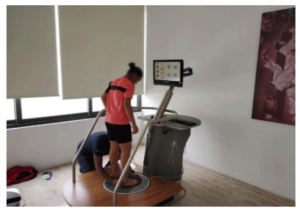 Figure 1: Athlete using the Prokin 252N system for assessment of Static and Dynamic stability.
Figure 1: Athlete using the Prokin 252N system for assessment of Static and Dynamic stability.
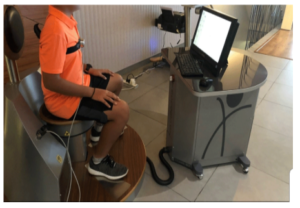
Figure 2: Athlete using the Balance Trunk MF system for assessment of Pelvic Stability.
Results
A total of 106 junior South Asian Badminton players underwent the assessment. Out of the 106 players, 62 were male players and 44 were female players. 96 of them were from India, 4 each from Nepal and Sri Lanka, while 2 players were from Maldives. The age group was between 8 and 15 years. The variables (and groups) used were gender (male, female), age (below 12, above 12), years of playing experience (less than 5, more than 5), body mass index (less than 18, more than 18), level at which they compete (amateur, professional), current pains in the body (present, absent), and clicks and/or catches in the body in the past 1 year (present, absent). Tecnobody machines have an in-built scale that categorises the athlete into either ‘poor’, ‘normal’, or ‘sportsperson’ depending on the result of their assessment. Each athlete is categorised based on his/her age, height and weight to find the percentage of athletes having ‘poor’, ‘normal’ or ‘sportsperson-like’ stability.
Static and Dynamic Stability- none of the variables showed a significant difference in ellipse area and total stability index between the groups (Chart 1 and Chart 2).
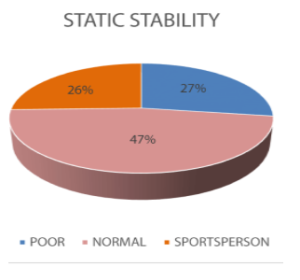 Chart 1: Static Stability.
Chart 1: Static Stability.
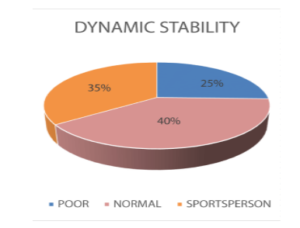
Chart 2: Dynamic Stability.
Pelvic Stability
Anti-clockwise error- We observed a significant difference in terms of age. 25 players were below the age of 12 while 81 were over 12 years of age. Mean anti-clockwise tracing error in of the 25 players below the age of 12 was 38.58 ± 14.89% and of those of the 81 players above 12 years was 28.56 ± 11.18%. The significant difference was 0.03. This showed that those above the age of 12 had better pelvic stability than those below the age of 12.
Clockwise error- We found a significant difference in the level at which the players compete. 39 players were playing at the amateur level whereas 67 were professional badminton players. Mean clockwise tracing error in of the 39 amateur players was 27.34 ± 9.66% and of the 67 professional players was 27.09 ± 13.83%. The significant difference was 0.047. This means that professional players had better pelvic stability compared to amateur players.
None of the other variables showed a significant difference.
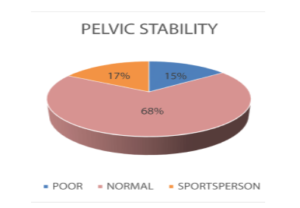
Chart 3: Pelvic Stability.
Discussion
Badminton is a dynamic equilibrium process which involves loss of balance in the air and restoration of balance after landing, and hence players need body coordination and dynamic balance [5]. In addition to moving back and forth on the court, players conduct various movement patterns during the game including twists, jumps, and swings to strike the shuttle-cock [6]. The game is characterized by a changing temporal structure, with actions of short period and high intensity coupled with short resting times [6]. Badminton requires specific physical conditioning in terms of action controls such as reaction time, foot stepping, and static or dynamic balances, which are essential motor demands in the sport [7]. Previous studies have highlighted the importance of stability in sport, and particularly in Badminton.
Based on our results, we found that there is a significant difference in anti-clockwise tracing error between players aged below and above 12. A study has shown that those with more development of skeletal, musculature and adipose tissue in their bodies tend to have better motion exercise responses [8]. This supports our results that pelvic stability improves with age. We also found a significant difference in clockwise tracing error between amateur and professional players. Previous studies have confirmed that efficient neuromuscular control of trunk stability and perfect trunk muscle recruitment patterns are vital factors for the control of spinal load in relation to position during the body’s movement [9]. This could suggest that professional players are training on their trunk control, core stability and doing exercises to improve spinal load distribution, resulting in a superior pelvic stability compared to the amateur players.
As shown in the above charts, the percentage of athletes falling under the ‘sportsperson’ category is very less in terms of static, dynamic, and pelvic stability. Also, the large number under the ‘poor’ category is further proof that stability training is not being given the importance it deserves. In today’s age of competitive sport, every player and coach is doing their level best to take the standard of play to the next level. Stability training needs to be incorporated in a player’s regimen to help improve performance output. Whether the players do not have access to specialists who can give them this form of training or whether this form of training is not being given the importance it needs, is debatable. Either way, research has shown [10] that it is an important factor in a player’s development and performance, and that currently it is being neglected by junior and upcoming badminton players.
This study opens up new grounds for further research. Further studies can address other variables not included in the present study. Additionally, targeted interventions are needed to improve stability for players and the effect of such improvements on performance need to be determined.
Conclusion
This study shows that there is a significant difference in pelvic stability in certain variables. However, no significant difference in static, dynamic and pelvic stability across other variables is a sign that stability not being given the importance it needs. Understanding its importance in overall improvement in athletic performance is a must and may help take their output to a whole new level.
Acknowledgements: We are grateful to the Badminton Association of India (BAI), Abhinav Bindra Targeting Performance, and Padukone-Dravid Centre for Sports Excellence (CSE) for their support in conducting this study.
References
- Mikkelsen F. Physical demands and muscle adaptation in elite badminton players.
- Omosegaard B. Design of Training using Scientific Data-A Practical Approach as a National Coach, 13. Ref.: https://goo.gl/fqp5Ca
- Hassan I. The Effect of Core Stability Training on Dynamic Balance and Smash Stroke Performance in Badminton Players. 2017 2: Ref.: https://goo.gl/Up5MZe
- Bressel E, Yonker JC, Kras J, Heath EM (2007) Comparison of static and dynamic balance in female collegiate soccer, basketball, and gymnastics athletes. J Athl Train. 42: 42-46.
- Ming-Min K, Qing L. The Interpretation of Functional Training and Its Application in Badminton. 2013.
- Phomsoupha M, Laffaye G (2015) The science of badminton: game characteristics, anthropometry, physiology, visual fitness and biomechanics. Sports Med. 45: 473-495.
- Laffaye G, Phomsoupha M, Dor F (2015) Changes in the Game Characteristics of a Badminton Match: A Longitudinal Study through the Olympic Game Finals Analysis in Men’s Singles. J Sports Sci Med. 14: 584-590.
- Rivas RC, Andries Junior O (2017) Sexual dimorphism and its implications on the performance and planning of women’s sports. Mov Percep. 7: 126-148.
- Granata KP, England SA (2006) Stability of Dynamic Trunk Movement. Spine (Phila Pa 1976). 31: E271-E276.
- Vora M, Ranawat D, Tiwari A, Arora M (2018) Analysis of static, dynamic, and pelvic stability in junior badminton players of South Asia. J Sports Med Ther. 3: 080-088.